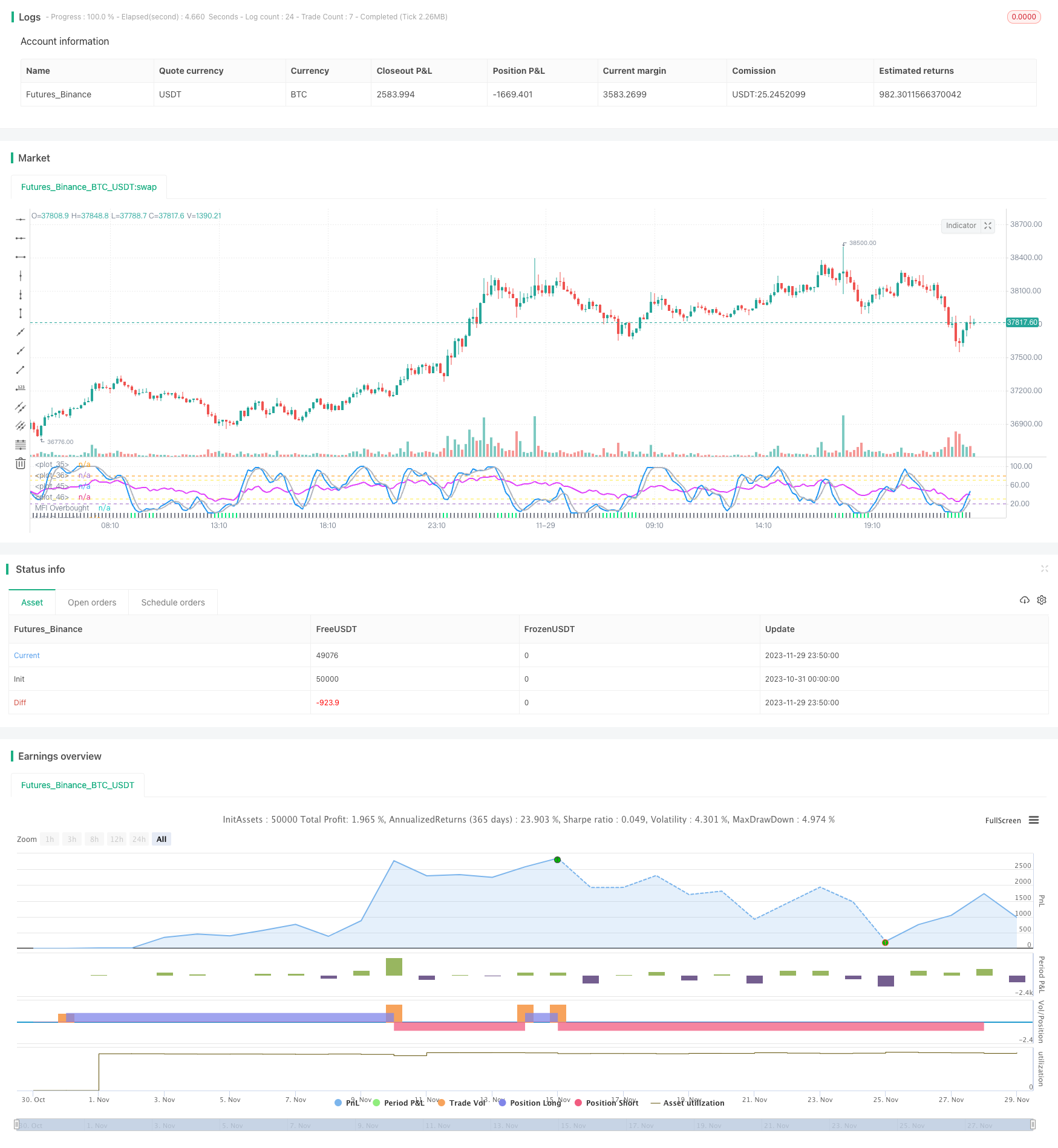
概述
本策略通过组合使用STOCH.RSI、RSI、双重策略、CM 威廉姆斯指标和货币流量指数(MFI)等多个指标,实现对市场波动的精确定位,looking for opportunties to long/short。当股票价格接近支撑或压力位时可以发出交易信号。该策略综合利用了多个指标的优势,通过指标互相验证,可有效减少误报率,增强信号的可靠性。
策略原理
STOCH.RSI 指标结合随机指标 Stochastic 和相对强弱指数 RSI 的优点。可以显示超买超卖区域,发现反转机会。
RSI 指标判断超买超卖,作为辅助验证信号。
双重策略判断 Stoch 和 RSI 的交叉情况,发出交易信号。
CM 威廉姆斯指标计算百分位范围。弹出该范围代表着市场的反转,作为辅助 Stoch.RSI 和 RSI 判断市场波动和反转的依据。
货币流量指数(MFI)判断资金流入流出情况,与 Stoch.RSI、RSI 互相验证,提高信号质量。
综上,该策略通过 Stoch.RSI、RSI、双重策略、CM 威廉姆斯指标和 MFI 等多个指标的组合,可以有效判断市场的超买超卖区域,定位反转机会,发出交易信号。多个指标的组合验证可以提高信号质量,减少误报。
优势分析
该策略主要有以下优势:
多指标组合,相互验证,可以减少误报,提高信号质量。
利用 STOCH.RSI、RSI 和 MFI 判断超买超卖区域,可有效定位市场反转点。
CM 威廉姆斯指标计算百分位范围,可以辅助判断市场波动和反转。
双重策略发出交易信号,操作简单,容易跟踪。
参数优化空间大,可以根据不同市场调整参数,适应性强。
风险分析
该策略也存在一些风险:
多指标组合运算比较复杂,对计算能力要求较高,不适合高频交易。
参数设置不当可能导致信号质量下降,应该选择适合自己的参数。
反转信号可能有滞后,需要结合更多指标判断走势。
交易次数可能较多,需要控制好资金利用效率。
对应的解决方法:
选择计算能力强的终端,针对参数进行优化。
做好回测,选择适合自己的参数组合。
与更多指标组合使用,提前判断走势。
优化止损机制,控制单笔交易风险。
优化方向
该策略可以从以下几个方向进行优化:
优化指标参数,选择最佳参数组合。
增加volume,利润因子等指标,提高交易选股能力。
结合更多聚合线,布林带等指标,提前判断支持阻力。
加入止损、入市筛选条件,控制风险。
不同品种、周期参数不一样,可以根据品种特点选择最佳参数。
总结
本策略通过 STOCH.RSI、RSI、双重策略、CM 威廉姆斯指标和 MFI 多指标精确组合,定位市场超买超卖区域,发现反转机会。相互验证信号,可以减少误报,提高信号质量。通过参数优化、增加其他判断条件等方式进一步完善,可以成为一个稳定、实用的交易策略。
/*backtest
start: 2023-10-31 00:00:00
end: 2023-11-30 00:00:00
period: 10m
basePeriod: 1m
exchanges: [{"eid":"Futures_Binance","currency":"BTC_USDT"}]
*/
//////////////////////////////////////////////////////////////////////////
//// STOCHASTIC_RSI+RSI+DOUBLE_STRATEGY+CM_WILLIAMS_VIX_FIX+MFI ////////
//////////////////////////////////////////////////////////////////////////
// This is a simple combination of integrated and published scripts, useful
// if you don't have a PRO account and want to bypass the 3 indicators limit.
// It includes:
// 1) Stoch.RSI
// 2) Relative strenght index (RSI)
// 3) Stochastic + RSI, Double Strategy (by ChartArt)
// 4) CM_Williams_Vix_Fix Finds Market Bottoms (by ChrisMoody)
// 5) Monetary Flow Index (MFI)
// For more details about 3) and 4) check the original scripts.
//@version=3
// @author GianlucaBezziccheri
strategy(title="Stoch.RSI+RSI+DoubleStrategy+CMWilliamsVixFix+MFI", shorttitle="Stoch.RSI+RSI+DoubleStrategy+CMWilliamsVixFix+MFI")
///STOCH.RSI///
smoothK = input(3, minval=1, title="Stochastic %K Smoothing")
smoothD = input(3, minval=1, title="Stochastic %K Moving Average")
lengthRSI = input(14, minval=1, title="RSI Lenght")
lengthStoch = input(14, minval=1, title="Stochastic Lenght")
RSIprice = close
rsi1 = rsi(RSIprice, lengthRSI)
k = sma(stoch(rsi1, rsi1, rsi1, lengthStoch), smoothK)
d = sma(k, smoothD)
plot(k, color=blue, linewidth=2)
plot(d, color=silver, linewidth=2)
h0 = hline(80)
h1 = hline(20)
fill(h0, h1, color=purple, transp=78)
///RSI///
up = rma(max(change(RSIprice), 0), lengthRSI)
down = rma(-min(change(RSIprice), 0), lengthRSI)
rsi2 = down == 0 ? 100 : up == 0 ? 0 : 100 - (100 / (1 + up / down))
plot(rsi2, color=fuchsia, linewidth=2)
band0 = hline(70)
band1 = hline(30)
fill(band0, band1, color=purple, transp=100)
///OVERBOUGHT-OVERSOLD STRATEGY///
StochOverBought = input(80, title="Stochastic RSI overbought")
StochOverSold = input(20, title="Stochastic RSI oversold")
ks = sma(stoch(close, high, low, lengthStoch), smoothK)
ds = sma(k, smoothD)
RSIOverBought = input( 70 , title="RSI overbought")
RSIOverSold = input( 30 , title="RSI oversold")
vrsi = rsi(RSIprice, lengthRSI)
if (not na(ks) and not na(ds))
if (crossover(ks,ds) and k < StochOverSold)
if (not na(vrsi)) and (crossover(vrsi, RSIOverSold))
strategy.entry("LONG", strategy.long, comment="LONG")
if (crossunder(ks,ds) and ks > StochOverBought)
if (crossunder(vrsi, RSIOverBought))
strategy.entry("SHORT", strategy.short, comment="SHORT")
///CM WILLIAMS VIX FIX///
pd = input(22, title="LookBack Period Standard Deviation High")
bbl = input(20, title="Bollinger Band Length")
mult = input(2.0 , minval=1, maxval=5, title="Bollinger Band Standard Devaition Up")
lb = input(50 , title="Look Back Period Percentile High")
ph = input(.85, title="Highest Percentile - 0.90=90%, 0.95=95%, 0.99=99%")
pl = input(1.01, title="Lowest Percentile - 1.10=90%, 1.05=95%, 1.01=99%")
hp = input(false, title="Show High Range (Based on Percentile and LookBack Period)?")
sd = input(false, title="Show Standard Deviation Line?")
wvf = ((highest(close, pd)-low)/(highest(close, pd)))*100
sDev = mult * stdev(wvf, bbl)
midLine = sma(wvf, bbl)
lowerBand = midLine - sDev
upperBand = midLine + sDev
rangeHigh = (highest(wvf, lb)) * ph
rangeLow = (lowest(wvf, lb)) * pl
col = wvf >= upperBand or wvf >= rangeHigh ? lime : gray
plot(hp and rangeHigh ? rangeHigh : na, title="Range High Percentile", style=line, linewidth=4, color=orange)
plot(hp and rangeLow ? rangeLow : na, title="Range High Percentile", style=line, linewidth=4, color=orange)
plot(wvf, title="Williams Vix Fix", style=columns, linewidth = 4, color=col, transp=85)
plot(sd and upperBand ? upperBand : na, title="Upper Band", style=line, linewidth = 3, color=aqua)
///MONETARY FLOW INDEX
length4 = input(title="MFI Length", defval=14, minval=1, maxval=2000)
src4 = hlc3
upper4 = sum(volume * (change(src4) <= 0 ? 0 : src4), length4)
lower4 = sum(volume * (change(src4) >= 0 ? 0 : src4), length4)
mf4 = rsi(upper4, lower4)
plot(mf4, color=yellow, style=line, linewidth=2, title="Monetary Flow Index")
overbought=hline(70, title="MFI Overbought", color=yellow)
oversold=hline(30, title="MFI Oversold", color=yellow)
fill(overbought, oversold, color=#9915ff, transp=100)